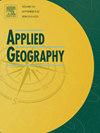Livelihood changes of migrants due to hydropower construction: A case study from Southwestern China
IF 4
2区 地球科学
Q1 GEOGRAPHY
引用次数: 0
Abstract
Hydropower construction is a rapidly expanding trend in developing countries, impacting local human well-being profoundly. This study applied the sustainable livelihoods framework to analyze the relationship between household livelihood assets, demographic characteristics, and livelihood strategy reselection. In 2022, this study assessed the livelihood of 283 households affected by the Wudongde Hydropower Station in the Jinsha River Basin of China. We found that (1) 76.7% of households had adopted an agricultural strategy before resettlement, while 94.0% of households engaged in a pure non-agricultural strategy after resettlement, including non-agricultural sustained (NAS), self-employed (SE), wage-employed (WE), and subsidy-dependent (SD). (2) Hydropower resettlement led to a significant reduction in natural assets by 58.4% and an increase in physical assets by 62.5%. The SD households experienced more pronounced declines in financial and human assets than the WE, SE, and NAS groups. (3) Relative changes in natural, physical, financial, and human assets, combined with household demographic characteristics including the ethnic minority ratio, the children and older people ratio, and average years of education, influenced the choices of livelihood strategies after resettlement. For the future, it is recommended that the government strengthen ethnic cohesion, promote entrepreneurial initiatives, provide employment skills training, and enhance social security assistance.
求助全文
约1分钟内获得全文
求助全文
来源期刊

Applied Geography
GEOGRAPHY-
CiteScore
8.00
自引率
2.00%
发文量
134
期刊介绍:
Applied Geography is a journal devoted to the publication of research which utilizes geographic approaches (human, physical, nature-society and GIScience) to resolve human problems that have a spatial dimension. These problems may be related to the assessment, management and allocation of the world physical and/or human resources. The underlying rationale of the journal is that only through a clear understanding of the relevant societal, physical, and coupled natural-humans systems can we resolve such problems. Papers are invited on any theme involving the application of geographical theory and methodology in the resolution of human problems.
 求助内容:
求助内容: 应助结果提醒方式:
应助结果提醒方式:


